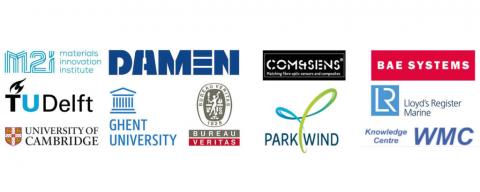Enabling Qualification of Hybrid Structures for Lightweight and Safe Maritime Transport (QUALIFY)
Cambridge University is a partner the QUALIFY project on certifying adhesive joints for primary maritime structures. The project is funded by the EU via the ERDF.
EU funding: € 2.268.946 Million
Total budget: € 3.781.577 Million
Duration: 49 months [July 2017 – December 2021]
At present, there are no certification guidelines to orient the naval industry when certifying new designs using hybrid assemblies (adhesively bonded, composite to metal connections), which limits their application to secondary structures. In QUALIFY, a multi-scale testing plan will be implemented by a consortium of 11 partners, to provide reliable insights into the long-term performance of hybrid joints operating in demanding marine environments. This will ultimately enable the increased use of adhesively bonded hybrid structures in primary structures in shipbuilding, and will also generate spin-offs to other industries.
Why is maritime & offshore industry interested in hybrid joints?
The application of hybrid bonded structures, where steel parts are adhesively bonded to plastic or composite parts can reduce the top weight of naval ships. An overall structural weight reduction of 10% translates into a 1-7% decreased fuel consumption and a similar reduction of harmful emissions, as well as cost savings of 176.000 euro/ship (on average) annually. Adhesive joints are increasingly used in marine construction, as they also offer the possibility of joining dissimilar materials, together with advantages brought by the adhesive process itself, which is cost-effective and provides the ease of maintenance and repair.
Adhesive bonding and lightweight materials have each gained widespread adoption by the aerospace and automotive industries, but adoption in the shipbuilding industry – particularly for manufacturers of large vessels such as freighters or naval ships – has lagged behind. The manufacturing processes in the aerospace and automotive industries are often conducted in controlled environments where dust and debris are uncommon and the temperature is regulated, whereas shipbuilding operations are often exposed to the open air, making the tight process control required for effective adhesive bonding more difficult. This difficulty contributes to general concerns regarding the reliability and fatigue life of an adhesive bond exposed to a harsh marine environment during its service lifetime.
What is still needed to enable widespread adoption of hybrid assemblies in the maritime sector?
Before adopting adhesive bonding for critical applications, manufacturers in the maritime industry want to know:
- Will this joint be reliable after twenty years of exposure to the harsh marine environment?
- Is it strong enough and tough enough? Can we accurately model the response of an adhesive joint?
- How can the properties of an adhesive joint be optimised? Is there an optimal thickness?
- What types of adhesive joint designs are best to withstand specific loading and service conditions?
These are the questions defining the scope of QUALIFY. Answering them will enable qualification of hybrid bonds in primary structures for marine applications.
Project objectives
QUALIFY will remove the barriers that currently prevent the application of adhesively bonded structures in primary structures, through an innovative combination of tests and techniques:
- Long term prediction models on the durability of the adhesive material and composite-to-metal joint configuration;
- Coupled effects of environment and loading conditions;
- Accelerated test methodology and innovative test set-up; real-time aging tests;
- Reliable inspection protocol and in-situ repair device to preserve the integrity of the monitoring mechanism within the bond.
The project will pursue the following three main objectives:
- Evaluate the long term structural performance of the adhesively bonded hybrid joint under representative operational and environmental conditions;
- Develop a reliable inspection and maintenance methodology for adhesively bonded hybrid joints;
- Develop a procedure (Guidelines) for the qualification of adhesively bonded hybrid joints in primary structures in marine applications.
Consortium
The approach proposed requires a combination of capabilities and experiences not available within the national borders of individual participants. A blend of expertise is needed, which our consortium brings together.
Partners:


